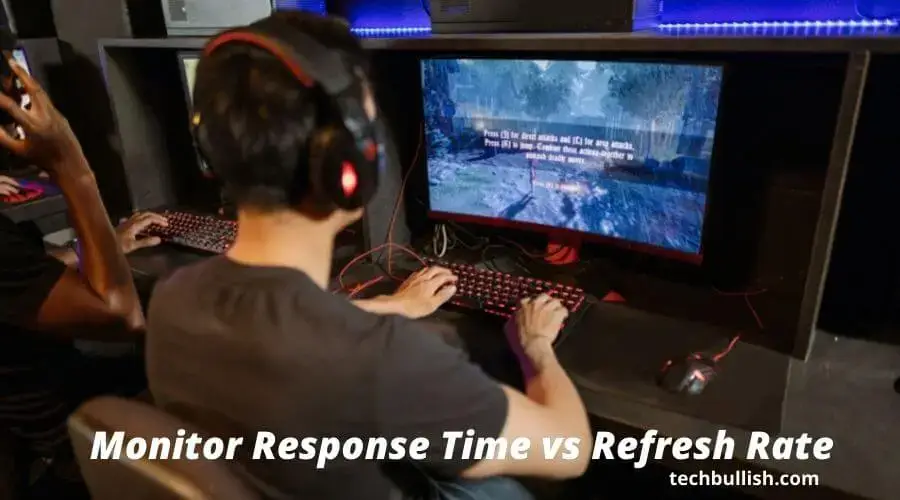Are you tired of staring at a mediocre monitor all day long? Monitors have become an essential tool for our daily lives, but do you know what sets apart a good monitor from a great one?
The difference between response time and refresh rate may seem like a foreign language, but it’s time to decode the jargon.
It’s crucial to understand why response time and speed are the true game-changers when it comes to choosing the perfect monitor for gaming and other purposes.
In this post, I will discuss in detail about the comparison of refresh rate vs response time to help you with a complete understanding.

Let’s get started!
Refresh Rate vs Response Time
Response time is the time it takes your monitor to change the pixels on the screen. This generally happens in fractions of a millisecond. The refresh rate on the other hand is the rate at which the screen can change the pixels. Although technically similar, response time and refresh rate are often used incorrectly when discussing monitors.
| Refresh Rate | Response Time |
| Measures how often a screen displays a new image every second, expressed in Hertz. | Measures how quickly a pixel can change from black to white and back to black, expressed in milliseconds. |
| Higher is generally better. | Lower is generally better. |
| A 60Hz refresh rate is standard, though some monitors go higher. | A response time of 5 ms or below is desirable(for gaming), with the sweet spot being 1 ms. |
| A higher refresh rate can result in smoother gameplay and reduced motion blur. | A lower response time can result in less ghosting and blurring. |
In short, refresh rate determines how many times per second a refresh is sent to the monitor, whereas response time determines how quickly the pixels update.
What Is the Response Time in A Monitor?
Response time for a monitor is the time it takes for a pixel to change colors.
Response time is commonly measured in milliseconds (or ms). A typical response time is about 8-9 ms.
A response time of less than 8 ms is considered very good and is mostly the territory of high-performance computer monitors.
Monitors with a response time of 16 ms are considered as good. But some rare monitors can go as low as 4 ms.
You can Read More Related to Monitor’s Response Time:
These would help you to know more about the different response times available and the comparison between them.
What Is the Refresh Rate of A Monitor?
The refresh rate, or refresh frequency, of a monitor or display, refers to the number of times that its hardware updates the image per second.
This metric is also known as the vertical refresh rate, scan frequency, or frame rate and is measured in Hz (Hertz) or “cps” (counts per second).
A higher refresh rate results in smoother graphics and video playback, making it particularly important for gamers who require quick reaction times.
Manufacturers typically advertise the refresh rate of their monitors or displays as a range of values.
However, a display can only support a single refresh rate. It can’t alternate between different refresh rates.
The operating system, graphics card, and display driver control the refresh rate.
You cannot change the refresh rate without a change in these settings. Many monitors have a default refresh rate.
However, it is possible to change the refresh rate to a different value.
Here are more related to Refresh Rates:
Is refresh rate more important than response time?
Both refresh rate and response time are important factors to consider when choosing a monitor for gaming or other activities. The ideal balance between the two depends on the intended use of the monitor.
A study on gamers found that competitive players who possess a certain skill level can benefit from a high refresh rate.
It can also positively affect the experience of some gamers as a visual effect is perceived as a Smoother movement. (Source: Huhti JP. The Effect Of High Monitor Refresh Rate On Game Experience
Refresh rate is the number of times per second that a display refreshes the image, measured in “hertz” (Hz).
Related: Does monitor Response Time matter?
Response time is the amount of time a pixel takes to change from one color to another.
If you’re a gamer, you’ve likely heard the term response time or refresh rate.
They’re used interchangeably by many, but they’re very different.
Refresh rate is an essential thing in gaming, so most gamers look for a high refresh rate.
But response time is also necessary, and it’s more important for other uses.
Does Response Time Change with Refresh Rate?
The popularity of gaming monitors has made refresh rate a household term.
It’s hard to find a monitor today that doesn’t advertise its “high refresh rate.” But that’s not the only factor to consider when looking for a gaming monitor.
Response time is also essential. It’s especially crucial when playing fast-paced video games.
When you play a video game with a high refresh rate, the higher the monitor’s response time, the more likely it is that the display will produce a double image.
It’s also crucial to a user’s experience with a monitor.
For instance, a monitor with a fast response time can eliminate motion blur and trailing. With a slower response time, the blur and trailing are more noticeable.
Does Refresh Rate Matter For Gaming?
A question that has come up in the last few years is whether or not refresh rate matters for gaming.
While it was believed that refresh rate did not matter as much in the past, it has since been discovered that refresh rate can significantly impact how immersive a game is.
It is now known that the refresh rate should be as high as possible.
A high refresh rate can help reduce motion blur and make a game feel more vibrant.
While the effects are hard to notice, content creators can help to make a game feel more immersive through their editing and storytelling.
A high refresh rate monitor can help with this, but most monitors do not have high refresh rates.
Which Is a Better Response Time for Monitor High or Low?
The response time of the monitor is one of the critical criteria when buying one.
Higher response means more time lag while working with graphics or video. If you are looking for a fast, smooth gaming experience, you will want to ensure that you find a monitor with a low response time.
The response time of the monitor is measured in milliseconds (ms). It is the time lag of a screen to refresh after getting new input or command.
The response time of a monitor ranges from 1 ms to 30 ms.
The fastest response time for a monitor is 0.5 ms which is exceptional. Anything below 5ms response time is good.
FAQs
Is refresh rate more important than response time?
What is the difference between Refresh Rate and Response Time?
What is Refresh Rate?
What is Response Time?
Do you want a high refresh rate for gaming?
How much faster is 144Hz than 60Hz?
Can the human eye tell the difference between 144Hz and 240Hz?
Conclusion
Let’s conclude the comparison of the refresh rate vs response time of a monitor.
When choosing a monitor, it is important to consider both the refresh rate and response time, but it is also important to consider other factors such as the panel type, resolution, and input lag.
The ideal balance between these factors depends on the intended use of the monitor.
By taking all of these factors into account, you can make an informed decision when choosing a monitor that meets your needs. Thank you for reading!

I’m Anirban Saha, Founder & Editor of TechBullish. With a B.Tech in Electronics and Communication Engineering, and 6+ years of experience as a software developer, I have expertise in electronics, software development, gadgets, and computer peripherals. I love sharing my knowledge through informational articles, how-to guides, and troubleshooting tips for Peripherals, Smart TVs, Streaming Solutions, and more here. Check Anirban’s Crunchbase Profile here.
